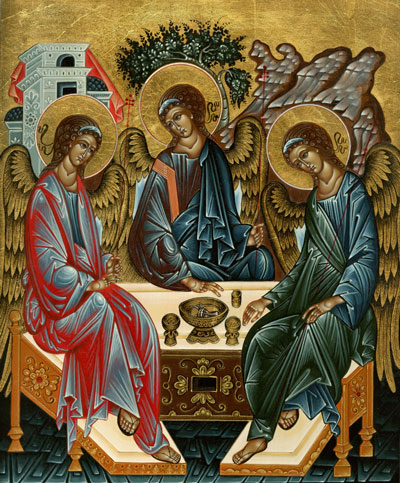 .
.
With the last two posts as background, let me try now and answer Anna-Mari’s question. She asked how all this “rethinking our God-images” works with an image of God as central as the Trinity.
***
 Anna-Mari:
Anna-Mari:
Again, the wisdom of our ancient doctrines insisted we not try and contain God in any mental image. Even a doctrine as cherished as the Trinity is inadequate. God can no more be contained in those three images, than in the images of King, Bridegroom, or Judge.
But that does not mean these images are bad. Each helps us talk about some aspect of our experience of the Divine.
Recall from the last post, we cannot contain God, but can experience God. These images are ways we make meaning of our experience. What they are not ITAL, is conclusive, definitive statements about the nature of the Divine. They are helpful ways to frame our glimpse-encounters of the transcendent, but that is all.
The earth we awaken in cares for us, teaches us, shapes and trains us. If we pay attention to the Presence behind the created world, it “fathers” us. In this way, we experience God as Father. Our scriptures are full of this helpful, meaning-making image of God.
Those who walked with Jesus experienced the Divine Presence in him as well. As enlightened, untainted humanity, Jesus revealed the Indwelling Divine in a profound way. Over time, we integrate this experience of the enlightened Son of God into our Story of the Divine.
Additionally, each of us carries within ourselves an Inner Voice, a Presence Within. This is one of the most intimate ways we experience the Divine. We get inner nudges and promptings, we sense wisdom from within, and we are captured by moments of Divine clarity and revelation. To make meaning of these experiences, we speak of the Spirit of God within.
 Each of these constructs is a meaning-making tool, an image to help us talk about transcendent experiences. They are a loose amalgamation of words and ideas to help us sort through elusive and ethereal experiences of a Reality beyond us. What they are not, are conclusive, definitive, statements about the nature of God.
Each of these constructs is a meaning-making tool, an image to help us talk about transcendent experiences. They are a loose amalgamation of words and ideas to help us sort through elusive and ethereal experiences of a Reality beyond us. What they are not, are conclusive, definitive, statements about the nature of God.But human nature being what human nature is, over time, we tend to calcify our images; make them just a bit more solid and concrete in our minds. Pretty soon, we forget all about our doctrine of ineffability, and convince ourselves that God really is the metaphor we constructed. We reduce God to an idea we can contain in our minds, and then fight to make sure everybody else does too.
How silly.
In the history of people seeking to experience the Divine, The Trinity has proven to be a profoundly helpful way to make meaning of our experience. However, that’s all it is… a mental construct, an image, a pointer, a simile. Like every other tool we use to talk about God, it cannot contain the Divine.
